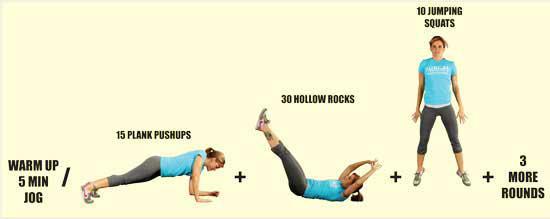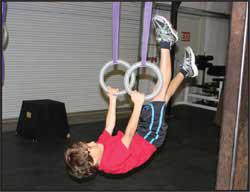Everyday Paleo (54 page)
Authors: Sarah Fragoso
Tags: #Diets, #Healthy Living, #Health & Fitness, #General

Workout 12
Workout 12:
Warm up with partner ball-toss drills (see the Partner Movements section below) or throw the ball against a wall solo, performing ten repetitions of either drill. For your workout, perform 3 rounds of 8 dumbbell push presses, 40 walking lunges (20 each leg), and 200 jump rope skips.

Workout 13
Workout 13:
Warm up with a 5-minute jog followed by 20 squats. For your workout perform 4 rounds of: 7 dumbbell squats, 7 jumping pull-ups, and 7 push-ups.

Workout 14
Workout 14:
Warm up with a 10-minute walk/jog. For your workout perform: 20 dumbbell dead lifts, 30 dumbbell push presses, 40 dumbbell swings, and 50 squats. Remember to stop and rest for a few seconds in the middle of your reps if you need to.

Workout 15
Workout 15:
Warm up with a 5-minute jog followed by 100 jump rope skips. For your workout perform 5 rounds of: 5 dumbbell dead lifts, 5 dumbbell push presses, and 5 dumbbell swings. After you finish 5 rounds of the preceding movements, finish your workout with a 400-meter run (or around the block).

Workout 16
Workout 16:
Warm up with a 10-minute walk/jog. For your workout, in 10 minutes perform as many rounds as possible of the following: 10 body rows, 10 dumbbell squats, and 10 broad jumps.

Workout 17
Workout 17:
Warm up with 300 jump rope skips. For your workout perform 5 rounds of: 20 walking lunges (10 on each leg), 10 sit-ups, and 10 box step-ups or jumps.

Workout 18
Workout 18:
Warm up with a 5-minute run. For your workout perform 4 rounds of: 15 plank push-ups, 30 hollow rocks, and 10 jumping squats.

Workout 19
Workout 19:
Warm up with 50 jumping jacks followed by 10 push-ups and 10 squats. For your workout perform: 100 jump rope skips and 50 sit-ups, 75 jump rope skips and 40 sit-ups, 50 jump rope skips and 30-sit-ups, and 25 jump rope skips and 15 sit-ups.

Workout 20
Workout 20:
Warm up with a 10-minute walk/run. For your workout perform 4 rounds of: a 400-meter run, 10 thrusters, and 10 push-ups.

Kids’ Fitness

A
s I mentioned during the introduction to the fitness section, kids today are way more sedentary than they should be. Getting your kids to exercise should be approached with a focus on fun rather than treated as a chore, a threat, or something that they have to do. The best way to convince children to do something is to model the behavior that you want them to follow. What does this mean? Get moving together! Kids are capable, if not more capable, of tackling the movements shown in this book. With that being said, it is also important to note that as adults we know how to push ourselves to the limit in and outside of the gym, but we should not push our kids outside of their limits when exercising, ever! Even if your child is seriously out of shape and/or overweight, pushing him or her too hard will result in your child rebelling from the idea of fitness or, even worse, getting injured during training.
If you watch children play naturally, they will run, walk, jump skip, throw a ball, wiggle, sit down for a while, roll around for a bit, take a drink of water, rest a bit more, look around, get back up, and run some more. Kids know how far to push themselves and will naturally stop and rest when they need to. Be respectful of your child’s innate ability to monitor his or her capability level. If you make exercise fun, kids will participate. If they need to stop and rest, then by all means let them! Have plenty of water available, and make use of the rest time to chat with your child about whatever he or she wants to chat about. When children exercise in a safe and supportive environment, they gain a sense of well-being and confidence that all kids should innately have. Furthermore, working out together is a wonderful way to reconnect, share, and discover the path back to health as a family.
In the upcoming section, we will look at Jaden showing us examples of how a kid can perform some of the same movements as adults, and below I give a few tips and some fun ways for kids to incorporate these movements into kid- and family-friendly workouts.
The Prepping Process
When you first start introducing exercise to your children, I suggest starting out by simply being more active together as a family. If your children have been extremely sedentary and you know that exercising is going to prove challenging, start the shift by simply taking walks together rather than turning on the TV or the games. Begin visiting parks and playgrounds and just have fun! If you tell your kids that they are going to follow an exercise plan, you will most certainly be met with resistance. Remember, exercise is supposed to be focused on fun, and I suggest approaching fitness with your family the same way you would if you were going to play a game together. Make it exciting, new, and intriguing! To introduce the movements to your children, let them know that you are going to teach them a new game! Teach them a few basic movements such as the squat and the push-up and incorporate those movements into a game of Simon Says. This game alone is fun for the whole family and gets everyone moving. Make sure each child gets a turn being “Simon” and see how fast your heart is racing!
My kids love to play Red Light Green Light, but instead of just running, we will also bear crawl, crab walk, broad jump, or leap like frogs! Kids love to play games like freeze tag, hide and seek, soccer, and catch—all of which are exercises hidden in a fun game being played outdoors. Many of these games can also be played inside! Move the furniture aside and have bear crawl races in the living room or simply turn on the radio and have each child make up his or her own dance routine to perform!
After your kids learn a few basic movements such as the squat, push-up, lunge, and sit-up, have them create a workout that you both can do! Jaden loves to make up workouts for us to do together as a family. He is so proud to be able to design something that we all can do as a group! Most importantly, praise your children. Do not make them feel bad if they are unable to do a complete movement. Just having your kids move at all is a step in the right direction. Kids will exercise without being told to if they’re simply given the opportunity.
Last but not least, find ways to get your children involved in the community. There are many organized sports available for kids to be a part of, and if they do not enjoy the competitive aspect of some youth organized sports, there are other options that are less aggressive, such as swimming, tennis, and golf. The martial arts are another wonderful sport to look into. Most martial arts programs do not focus only on competition, but also on learning the techniques, being respectful, and on general fitness. My two oldest boys both have taken martial arts classes, and we have had wonderful experiences with the programs. Jaden continues to train in Kenpo Karate and it has been amazing to see his self-confidence, self-control, and positive demeanor improve.

Squat
As described in the first part of the fitness section, the squat is a natural movement that we perform several times a day. However, children these days spend a great deal of time indoors playing video games and watching television rather than engaging in normal everyday movements like the squat, which leads to less development in their primary muscles. By performing squats on a regular basis, children not only become more fit, but they also learn how to correctly bend to pick up objects, which will help them later on in life.
MUSCLES USED: Quadriceps, Gluteals, and Hamstrings

1)
To begin the movement, Jaden stands with his feet spread roughly shoulder width apart, his back is straight, and his arms positioned straight out in front of him for balance.
2)
Jaden performs a squat exactly as outlined in the previous squat sequence that I demonstrated.
3)
Still keeping his back perfectly straight, Jaden pushes through his heels and returns to the standing position. The same rules for modification apply to children. If your child is not capable of squatting to full depth, let him or her practice by squatting to a beanbag or a size-appropriate chair.
Rocket Jump
The rocket jump is very similar to the squat jump that I demonstrated earlier in the fitness section, but when kids perform the rocket jump, they should definitely make rocket noises! If your kids cannot squat down to full depth, have them simply bend down as much as possible by reaching their fanny back and bending at the knees, and they can still jump into the air . . . and have fun being a rocket!
MUSCLES USED: Abdominals, Gluteals, Quadriceps, Hamstrings, and Calves

1)
Jaden stands in the squat stance.
2)
As Jaden reaches his fanny back and bends at the knees, he keeps his back straight and his chest up as much as possible. His eyes are looking straight ahead and his fingertips are on the ground.
3)
Pushing through his heels, Jaden jumps straight up out of the squat position with arms outstretched overhead.
4)
Jaden lands with bent knees on his forefoot and then transfers his weight to his heels. From here, he will immediately jump again.
Lunge
When kids perform walking lunges, it builds up their gluteal and inner-thigh muscles. In addition to helping improve their overall athleticism, it also increases their strength and self-confidence. As with the squat, if they are unable to perform a lunge at the correct depth, just have them walk with giant steps. They will still be using those important muscles and working toward the full movement.
MUSCLES USED: Gluteals, Hamstrings, Quadriceps, and Adductors

1)
Jaden stands with his feet positioned together.
2)
Jaden performs the same lunge described earlier in the book. Make sure your child starts out slow and maintains his balance by stepping a little to the right or to the left, depending on which foot he is using.
3)
Jaden pushes up through his heel and is ready to repeat the movement with his opposite leg. Notice that Jaden keeps his chest upright and his gaze forward.
Push-Up
When it comes to push-ups, I recommend starting your child with the easiest version possible, which is with his or her hands against a wall. Push-ups can be just as difficult for children as they are for adults, and if they start with a version too difficult, they can quickly get discouraged. Once your child has an easy time with the wall variation, increase the difficulty by moving on to chair push-ups. And once chair push-ups are a cinch, progress to the modified knee push-up demonstrated earlier. As long as you progress slowly in this fashion, your child will eventually be able to execute the full movement Jaden demonstrates below.
